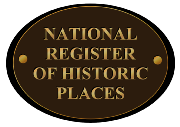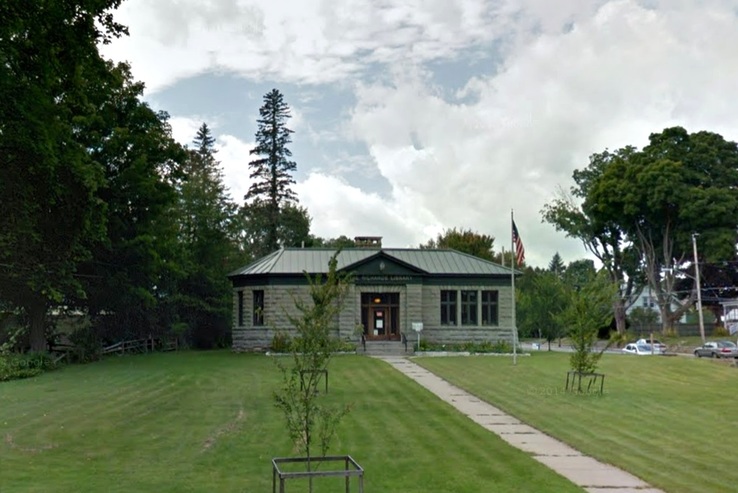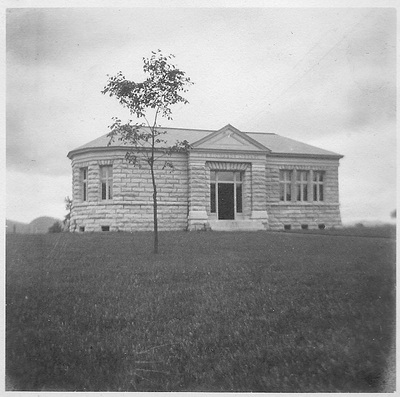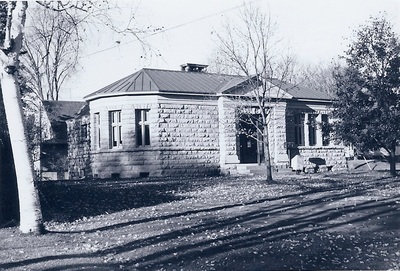c. 1900
|
Richards Library (corner of Library Avenue and Elm Street)
The contributing Richards Library is an intact and distinguished example of Colonial Revival period design dating from 1900. The 1- story, stone structure was constructed of native, rough-coarsed granite and features an accentuated front entrance with a decorative pediment supported by pilasters. In 1911, a rear addition was constructed which nearly doubled the size of the building, and in 1965, a second rear addition (to the west of the 1911 addition) was constructed. These have been executed with utmost attention to preserving the original architectural character of the building, which remains an intact and historically significant resource related to the civic and educational development of the community.
The contributing Richards Library is an intact and distinguished example of Colonial Revival period design dating from 1900. The 1- story, stone structure was constructed of native, rough-coarsed granite and features an accentuated front entrance with a decorative pediment supported by pilasters. In 1911, a rear addition was constructed which nearly doubled the size of the building, and in 1965, a second rear addition (to the west of the 1911 addition) was constructed. These have been executed with utmost attention to preserving the original architectural character of the building, which remains an intact and historically significant resource related to the civic and educational development of the community.
Richards Library - In 1890, sisters Mary Richards Kellogg and Clara Richards, granddaughters of Colonel B. P. Burhans and Pelatiah Richards, started the Warrensburgh Circulating Library in the Episcopal Church Parish House with a few bookshelves and their own private collection of 421 volumes. An annual subscription of $2.00 allowed one book to be borrowed at a time. It proved to be very popular, but inadequate to the demand. In 1900 the two sisters decided to erect a building. The land, the fully equipped building and an endowment fund of $40,000 for its operation were donated by Mary and Clara. The limestone was taken from a quarry on the James Hammond farm, near the County Home. The University of the State of New York granted a charter on July 1, 1901. On August 1, 1901, the Richards Public Library was presented to the townspeople. In 1911 an addition was also financed by the sisters. On December 22, 1914 a fire destroyed all but the stone walls and chimney. Most of the books were consumed. Undaunted, Mary and Clara would rebuild the library, but asked the Town to replace the books. The rebuilt library opened September 23, 1915. New additions were built in 1963 with a bequest from Albert L. Emerson and in 1974, with major interior remodeling accomplished through the generosity of Faustine Bennett and Maurice Ashe. In 2001 the Library initiated plans to double the size of the building and provide proper access. Grants from the Charles R. Wood Foundation, generously matched by local contributors, enabled a start to this ambitious project. An architect was hired and construction of the exterior shell was completed in 2006. In 2012 the Library Trustees proposed a library taxing district that would coincide with Warrensburg Central School District and provide the library with a secure annual income to cover operating costs. In a referendum in May of that year, the voters approved. Grants and remaining endowment funds enabled a speedy completion of the expansion.
“First built in 1900 it was razed by fire in 1914 and rebuilt. The architect was A.W. Fuller of Albany. The stone is of native limestone from the quarries of David Brown on County Mountain. Original cost is noted at $15,000."
Addition to children’s room in 1965.
Doubling the building footprint, an addition completed in 2012 included extensive interior renovations that allowed for the installation of computers for public use, the inclusion of a reading area, an enhanced reception desk area and a public meeting area accessed by an elevator.
Although the benefactors intended for this to be a free public library it became an annual taxed debt in 2012.
(1980) “The library is the sole granite building on Elm Street and one of the last buildings in town to be built of granite. Its shape is harmonious with the mostly late Victorian homes in its vicinity. The fact that it is only one story, made of stone and set well back from the street helps to distinguish it from its neighbors.
“The building is made of stone that was quarried locally. It houses a small collection of Far Eastern artifacts, featuring porcelain dishes, some silks, a wooden chest, and some ivory pieces. Some items of local historical interest are also housed here: in fact, until the establishment of the Museum of Local History a few years ago, the library served as the town’s museum.
“Until the construction of the library building , books were housed in the Episcopal church buildings. The building was the gift of Richards sisters and was constructed at a time when a number of the town’s major public buildings were being constructed. The fact that the construction was financed primarily by two people reflects another rather common occurrence- that many of the town’s wealthy citizens often made substantial contributions to the local community’s public buildings.”
“First built in 1900 it was razed by fire in 1914 and rebuilt. The architect was A.W. Fuller of Albany. The stone is of native limestone from the quarries of David Brown on County Mountain. Original cost is noted at $15,000."
Addition to children’s room in 1965.
Doubling the building footprint, an addition completed in 2012 included extensive interior renovations that allowed for the installation of computers for public use, the inclusion of a reading area, an enhanced reception desk area and a public meeting area accessed by an elevator.
Although the benefactors intended for this to be a free public library it became an annual taxed debt in 2012.
(1980) “The library is the sole granite building on Elm Street and one of the last buildings in town to be built of granite. Its shape is harmonious with the mostly late Victorian homes in its vicinity. The fact that it is only one story, made of stone and set well back from the street helps to distinguish it from its neighbors.
“The building is made of stone that was quarried locally. It houses a small collection of Far Eastern artifacts, featuring porcelain dishes, some silks, a wooden chest, and some ivory pieces. Some items of local historical interest are also housed here: in fact, until the establishment of the Museum of Local History a few years ago, the library served as the town’s museum.
“Until the construction of the library building , books were housed in the Episcopal church buildings. The building was the gift of Richards sisters and was constructed at a time when a number of the town’s major public buildings were being constructed. The fact that the construction was financed primarily by two people reflects another rather common occurrence- that many of the town’s wealthy citizens often made substantial contributions to the local community’s public buildings.”









